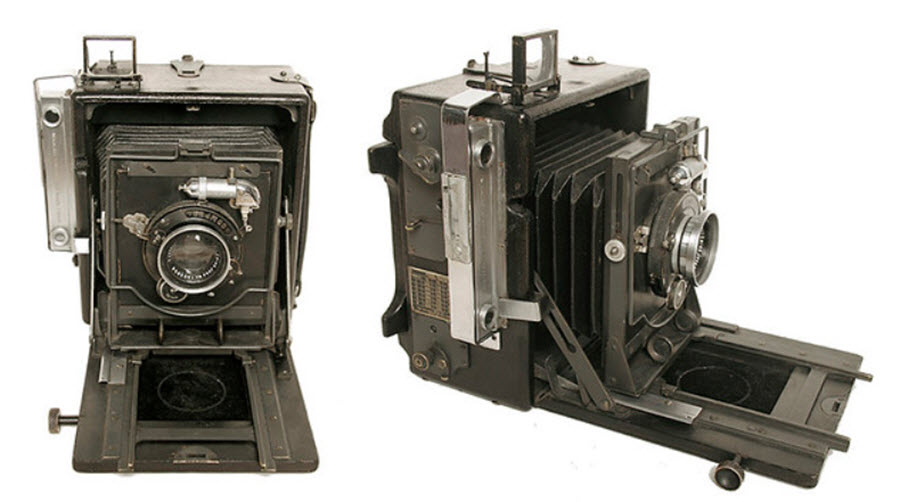Contents
Graflex was a United States manufactorer chiefly famous for creating the Speed Graphic, a camera much loved by photojournalists during much of the 20th century. You can even see a stylized logo of the Speed Graphic on the flag of the New York Daily News.
With roots going back to the 19th century, Graflex released their first camera just before the turn of the century, and produced large and medium format press cameras from 1912 to 1973.
The Graflex product range also included other things, such as rangefinder cameras, SLR cameras, and TLR cameras. During Graflex´s time as a division of Eastman Kodak, the Century Studio Camera was marketed under both the Graflex and the Kodak nameplates.

The Graflex Speed Graphic
During much of the 20th century, the Speed Graphic in its various incarnations was the quintessential press camera. These folding cameras, manufactored from 1912 to 1973, had a focal plane shutter but no SLR swinging mirror or through-the-lens viewing. The design made the camera comparatively lighweight and it could be folded into a rugged boxy shape; two features greatly appreciated by press photographers on the go.
In the 21st century, surviving Speed Graphic cameras are chiefly used by photo artists who seek supreme depth of field control and image detail.
Trivia
- In the period 1942-1953, all Pulitzer Prize-winning photographs had been taken with Speed Graphic cameras.
- The top-to-bottom motion of the Speed Graphic´s focal plane shutter exposed the upper portion of the film first. Because of this, photographs of fast-going cars had a tendency to make the wheels look oval, as if they were leaning forward. This became such a staple of car photography that cartoonists still draw wheels like this to indiciate fast speed.
- The lightsaber prop used in the 1977 movie Star Wars was a modified Graflex 3-cell flashgun designed to hold flash bulbs for Speed Graphic cameras.
Examples of notable users
- New York City press photographer Arthur “Weegee” Fellig
- Photographer and Aperture co-founder Barbara Morgan
- The twin brothers Frank P. Hoy (photographing for the Washington Post) and Tom Hoy (photographing for the Washington Evening Star).
- Joe Rosenthal, who used a Speed Graphic to take the iconic and Pulitzer Prize-winning photo of U.S. Marines raising the U.S flag on Iwo Jima in 1945.
- Yasushi Nagao, who won the 1960 World Press Photo of the Year award and the 1961 Pulitzer Prize for his Speed Graphic photo showing Japanese ultranationalist Otoya Yamaguchi assassinating Japanese Socialist Party leader Inejiro Asanuma.
- Photojournalist David Burnett, who is still using Speed Graphic cameras in the 21st century
The Graflex Crown Graphic
Photographers who wanted something even smaller and lighter than the Speed Graphic could opt for Graflex´s Crown Graphic, as the Crown had no focal plane shutter. This sacrifice made the Crown about one inch smaller and one pound lighter, and the absence of a focal plan shutter made it possible to mount a lense closer to the film plane.
Company history
Background
In 1887, the gas lamp company Folmer and Schwing Manufactoring Company was founded in New York City by the William F. Folmer and William E. Schwing.
The business managed to survive the decline in gas lamp use by expanding into other markets, including photographic equipment and bicylces.
The first Graflex cameras
The Folmer and Schwing Manufactoring Company introduced the first Graflex camera in 1899. Their cameras became such a success that the company decided to cease producing other things and only work within the field of photography.
The 1899 camera is known alternatively as Graflex Reflex and Graflex Single Lense Reflex (SLR). It had swinging-mirror, through-the-lens viewing mechanisms and a focal plane shutter, and it quickly became a big hit with press photographers, sports photographers and fine art photographers. These early Graflex cameras came with a cloth shutter with a narrow slit that moved rapidly across the film plane, exposing only one small strip of the film at any given moment.
Eastman Kodak
The Folmer and Schwing Manufactoring Company was acquired by George Eastman (founder of the Eastman Kodak Company) in the early 1900s and soon became the Folmer Graflex Division of Eastman Kodak.
During this period, Graflex cameras were manufactored in Eastman Kodak´s Rochester plant for professional equipment.
Graflex Inc.
In 1926, Kodak divested itself of its professional equipment division to comply with the Sherman Anti-Trust Act, and the Folmer Graflex Division became the Folmer Graflex Corporation. In 1946, the name was changed to Graflex Inc.
Graflex Inc. was an independent company until 1956 when it was acquired by the General Precision Equipment Corporation. After twelve years as a division of GPEQ, it was purchased by the Singer Corporation, who ran it as a division until 1973.
The end of Graflex
In 1973, Singer put an end to Graflex, and the equipment was sold to the Toyota Corporation.
This article was last updated on: October 5, 2020
